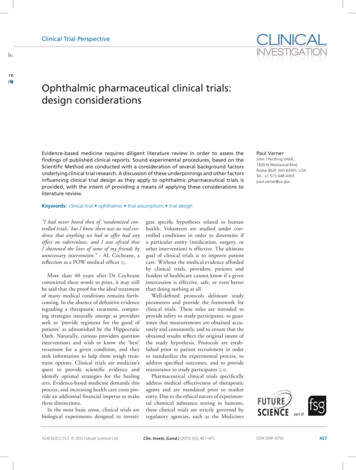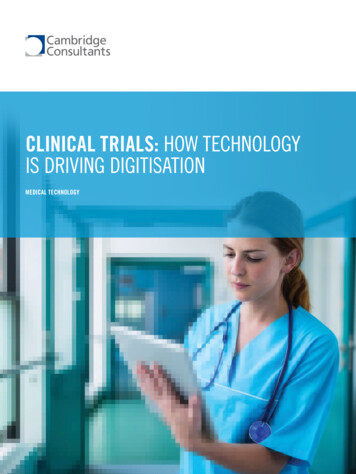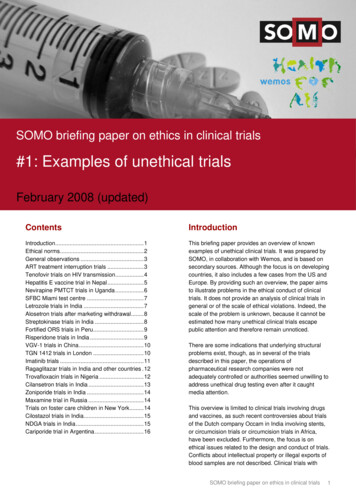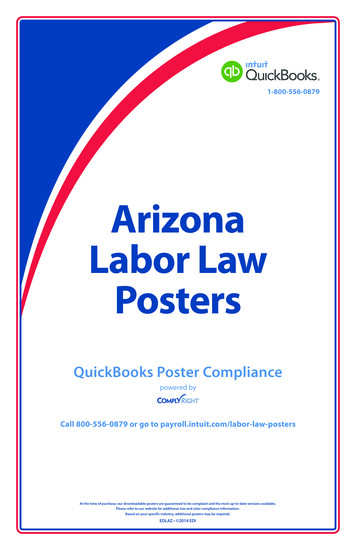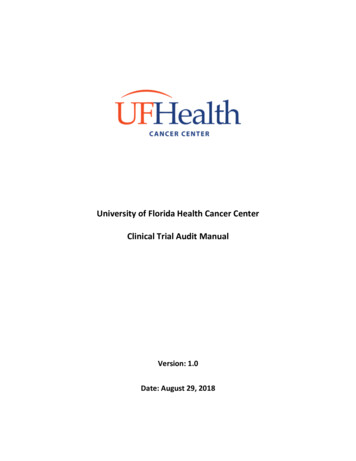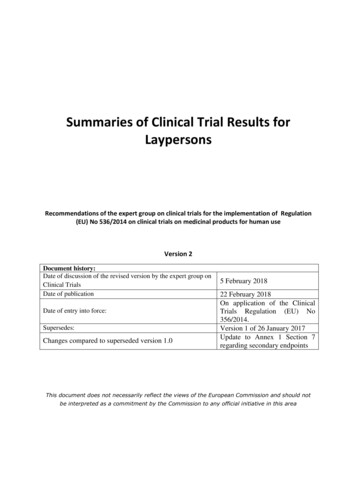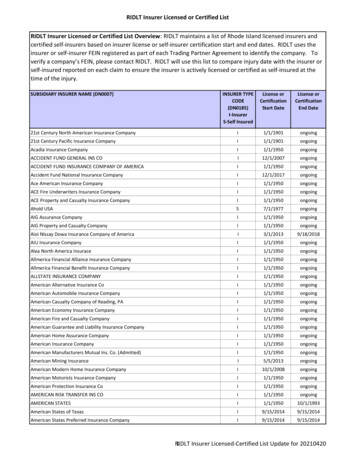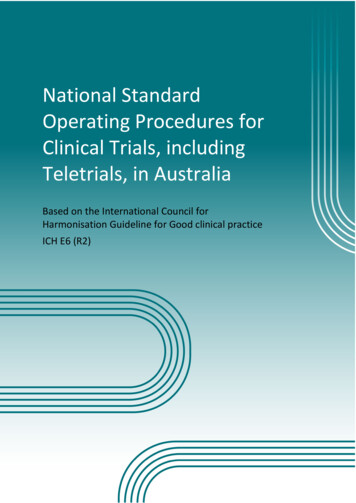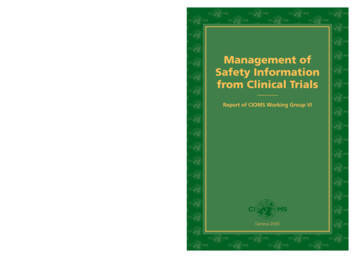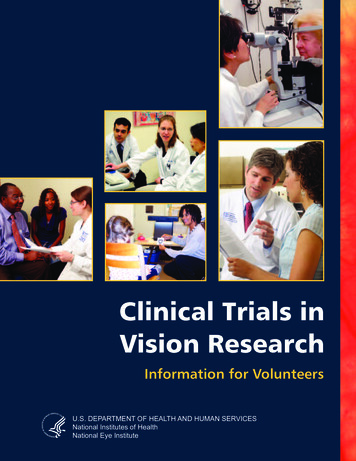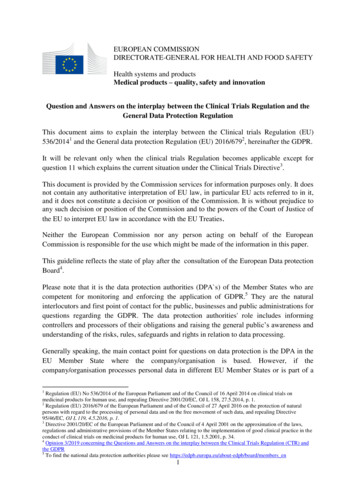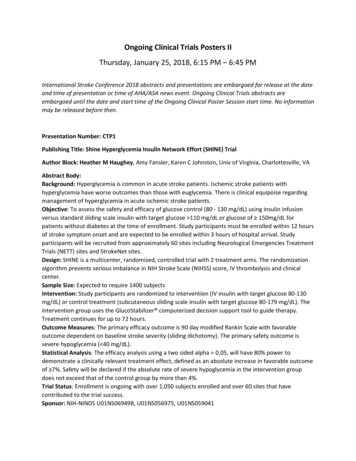
Transcription
Ongoing Clinical Trials Posters IIThursday, January 25, 2018, 6:15 PM – 6:45 PMInternational Stroke Conference 2018 abstracts and presentations are embargoed for release at the dateand time of presentation or time of AHA/ASA news event. Ongoing Clinical Trials abstracts areembargoed until the date and start time of the Ongoing Clinical Poster Session start time. No informationmay be released before then.Presentation Number: CTP1Publishing Title: Shine Hyperglycemia Insulin Network Effort (SHINE) TrialAuthor Block: Heather M Haughey, Amy Fansler, Karen C Johnston, Univ of Virginia, Charlottesville, VAAbstract Body:Background: Hyperglycemia is common in acute stroke patients. Ischemic stroke patients withhyperglycemia have worse outcomes than those with euglycemia. There is clinical equipoise regardingmanagement of hyperglycemia in acute ischemic stroke patients.Objective: To assess the safety and efficacy of glucose control (80 - 130 mg/dL) using insulin infusionversus standard sliding scale insulin with target glucose 110 mg/dL or glucose of 150mg/dL forpatients without diabetes at the time of enrollment. Study participants must be enrolled within 12 hoursof stroke symptom onset and are expected to be enrolled within 3 hours of hospital arrival. Studyparticipants will be recruited from approximately 60 sites including Neurological Emergencies TreatmentTrials (NETT) sites and StrokeNet sites.Design: SHINE is a multicenter, randomized, controlled trial with 2 treatment arms. The randomizationalgorithm prevents serious imbalance in NIH Stroke Scale (NIHSS) score, IV thrombolysis and clinicalcenter.Sample Size: Expected to require 1400 subjectsIntervention: Study participants are randomized to intervention (IV insulin with target glucose 80-130mg/dL) or control treatment (subcutaneous sliding scale insulin with target glucose 80-179 mg/dL). Theintervention group uses the GlucoStabilizer computerized decision support tool to guide therapy.Treatment continues for up to 72 hours.Outcome Measures: The primary efficacy outcome is 90 day modified Rankin Scale with favorableoutcome dependent on baseline stroke severity (sliding dichotomy). The primary safety outcome issevere hypoglycemia ( 40 mg/dL).Statistical Analysis: The efficacy analysis using a two sided alpha 0.05, will have 80% power todemonstrate a clinically relevant treatment effect, defined as an absolute increase in favorable outcomeof 7%. Safety will be declared if the absolute rate of severe hypoglycemia in the intervention groupdoes not exceed that of the control group by more than 4%.Trial Status: Enrollment is ongoing with over 1,050 subjects enrolled and over 60 sites that havecontributed to the trial success.Sponsor: NIH-NINDS U01NS069498, U01NS056975, U01NS059041
Author Disclosure Block: H.M. Haughey: Research Grant; Significant; NIH-NINDS U01 NS069498. A.Fansler: None. K.C. Johnston: Employment; Modest; Special employee of federal government NINDSadvisory council. Research Grant; Modest; NIH-NINDS U01NS056975, NIH-NINDS U01 NS059041, NHLBIR01 HL128492, NIH-NINDS U01 NS080168, NIH-NINDS U01 NS079077. Research Grant; Significant; NIHNINDS U01 NS069498. Honoraria; Modest; ANA, AAN, NINDS. Consultant/Advisory Board; Modest;Diffusion Pharmaceuticals, Roche/Genentech, Biogen, NIH-NHLBI SPRINT DSMB.
Presentation Number: CTP2Publishing Title: PreHospital Acute Stroke Therapy with Trans Sodium Crocetinate (PHAST-TSC)Author Block: Andrew M Southerland, Univ of Virginia Health System, Charlottesville, VA; NersesSanossian, Univ of Southern California, Los Angeles, CA; John L Gainer, Guy M Chisholm III, DiffusionPharmaceuticals, Inc., Charlottesville, VA; Steven Piantadosi, Cedars-Sinai Medical Ctr, Los Angeles, CA;Karen C Johnston, Univ of Virginia Health System, Charlottesville, VA; Jeffrey L Saver, Univ of California,Los Angeles, Los Angeles, CAAbstract Body:Background: Prehospial neuroprotection is a desirable treatment strategy in acute ischemic stroke,stabilizing threatened brain to deliver more salvageable tissue to hospital-administered reperfusiontreatments. Trans sodium crocetinate (TSC, Diffusion Pharmaceuticals, Inc.) is a promisingneurotherapeutic that enhances the diffusion of oxygen to hypoxic tissues by altering the structure ofwater molecules in plasma. TSC has shown benefit for both ischemic and hemorrhagic stroke inpreclinical studies, and safety in early human trials in patients with glioblastoma multiforme andperipheral arterial disease.Objective: To preliminarily characterize the safety and efficacy of patients with suspected acute strokein the prehospital setting. Design: Phase II randomized, double-blind, placebo-controlled trial.Population Studied: Ambulance-transported patients age 40-90 yo, within 2 hours of onset of suspectedacute stroke by the modified Los Angeles Prehospital Stroke Screen. The planned sample size will be 80participants/group (n 160). Intervention: Single injection of intravenous TSC (0.25 mg/kg) versusplacebo (normal saline) during ambulance transport.Outcome Measures: The primary efficacy outcome will be disability-related quality of life at 90 days, onthe utility-weighted modified Rankin Scale (UW-mRS). Secondary efficacy outcomes include disabilitylevel (ordinal mRS) and functional independence (mRS 0-2) at 90d. Exploratory efficacy outcomesinclude activities of daily living (Barthel Index), neurologic deficit (NIH Stroke Scale), health-related QOL(EQ-5D). Safety endpoints include all serious adverse events and all-cause mortality, with oversight byan independent DSMB.Analysis: The study will use a multistage, gatekeeper analytic plan. The lead primary analysis of the UWmRS will be performed in patients with final diagnoses of acute cerebral ischemia (explanatory efficacyin target patients). The hierarchical, nested, co-primary analysis of the UW-mRS will be performed in allenrolled patients, including final diagnosis cerebral ischemia, intracranial hemorrhage, andneurovascular mimics (pragmatic efficacy analysis as a treatment strategy).Trial Status: Anticipated enrollment beginning in 2018.Author Disclosure Block: A.M. Southerland: Employment; Modest; Section Editor, Neurology(R)Podcast. Research Grant; Modest; HRSA GO1RH27869-01-00. Honoraria; Modest; AHA/ASA. ExpertWitness; Modest; Legal Expert Review. Ownership Interest; Modest; U.S. Provisional Patent ApplicationSerial No. 61/867,477. N. Sanossian: None. J.L. Gainer: Employment; Significant; Chief Scientific Officer,Diffusion Pharmaceuticals, Inc. G.M. Chisholm: Consultant/Advisory Board; Significant; Chair, ScientificAdvisory Board, Diffusion Pharmaceuticals, Inc. S. Piantadosi: None. K.C. Johnston: Employment;Modest; Special employee of federal government NINDS advisory council. Research Grant; Modest; NIHNINDS U01NS056975, NIH-NINDS U01 NS059041, NHLBI R01 HL128492, NIH-NINDS U01 NS080168, NIH-
NINDS U01 NS079077, NHLBI HHSN268200900040C. Research Grant; Significant; NIH-NINDS U01NS069498. Honoraria; Modest; ANA, AAN, NINDS. Consultant/Advisory Board; Modest; DiffusionPharmaceuticals, Roche/Genentech, Biogen, SPRINT DSMB. J.L. Saver: Consultant/Advisory Board;Modest; Diffusion Pharmaceuticals, Inc.
Presentation Number: CTP3Publishing Title: Carotid Revascularization and Medical Management for Asymptomatic CarotidStenosis: CREST-2 UpdateAuthor Block: James F Meschia, Mayo Clinic Florida, Jacksonville, FL; Brajesh K Lal, Univ of Maryland,Baltimore, MD; George Howard, Univ of Alabama at Birmingham, Birmingham, AL; Gary S Roubin,Brookwood Medical Ctr, Birmingham, AL; Robert D Brown Jr, Mayo Clinic, Rochester, MN; Kevin MBarrett, Mayo Clinic Florida, Jacksonville, FL; Seemant Chaturvedi, Univ of Miami Miller Sch of Med,Miami, FL; Marc I Chimowitz, Medical Univ of South Carolina, Charleston, SC; Bart M Demaerschalk,Mayo Clinic, Phoenix, AZ; Virginia J Howard, Univ of Alabama at Birmingham, Birmingham, AL; JohnHuston III, Mayo Clinic, Rochester, MN; Ronald M Lazar, Univ of Alabama at Birmingham, Birmingham,AL; Wesley S Moore, Univ of California Los Angeles, Los Angeles, CA; Claudia S Moy, Natl Inst ofNeurological Disorders and Stroke, Bethesda, MD; Tanya N Turan, Jenifer H Voeks, Medical Univ ofSouth Carolina, Charleston, SC; Thomas G Brott, Mayo Clinic Florida, Jacksonville, FLAbstract Body:Introduction: Over 100,000 carotid revascularization procedures are done annually in the US forasymptomatic carotid arterial stenosis. The safety of carotid endarterectomy (CEA) and carotid stenting(CAS), and the efficacy of medical therapy in altering the progression of atherosclerosis have improved.Therefore, the applicability of prior randomized trials in asymptomatic carotid stenosis to currenttreatment decisions has been called into question.Methods: The aim of the NINDS-funded CREST-2 is to compare CEA and intensive medical therapy (IMT)versus IMT alone (n 1240), and CAS and IMT versus IMT alone (n 1240), through two parallelrandomized clinical trials at approximately 120 medical centers, including collaboration with NIHStrokeNet. The composite primary outcome is any stroke or death within 44 days after randomization oripsilateral ischemic stroke thereafter up to 4 years. Secondary outcomes include cognitive function,which is assessed on a regular schedule through computer-assisted telephone interview. IMT is directedcentrally and includes tight control of blood pressure (systolic target 140 mm Hg) and cholesterol (LDLtarget 70 mg/dl) as well as lifestyle coaching.Results: As of October 8, 2017, the Site Selection Committee has approved 159 sites, of which 113 (71%)have enrolled at least one patient. The Surgical and Interventional Management Committees havecredentialed 370 surgeons and 160 interventionists. An additional 182 interventionists have beenapproved to submit additional cases via the CREST-2 Companion Registry which provides a CMSreimbursed pathway for full credentialing in CREST-2. 784 patients have been randomized, 383(49%)patients in the endarterectomy trial, and 401 (51%) patients in the stent trial.Conclusion: CREST-2 is designed to identify the best approach for asymptomatic carotid stenosis. Anupdate will be provided regarding the numbers of patients randomized, centers certified, as well assurgeons and interventionists fully approved. The CREST-2 Registry will provide the option of CAS whileenhancing interventionists’ credentials for participation in CREST-2.Author Disclosure Block: J.F. Meschia: None. B.K. Lal: None. G. Howard: None. G.S. Roubin: None. R.D.Brown: None. K.M. Barrett: None. S. Chaturvedi: None. M.I. Chimowitz: None. B.M. Demaerschalk:None. V.J. Howard: None. J. Huston: None. R.M. Lazar: None. W.S. Moore: None. C.S. Moy: None. T.N.Turan: None. J.H. Voeks: None. T.G. Brott: None.
Presentation Number: CTP4Publishing Title: Extension of Stroke Care by Added Neuroprotection to Endovascular TreatmentAuthor Block: Charlotte Zerna, Mayank Goyal, Bijoy K Menon, Univ of Calgary, Calgary, AB, Canada;Michael Tymianski, Univ of Toronto, Toronto, ON, Canada; Michael D Hill, Univ of Calgary, Calgary, AB,Canada; ESCAPE-NA1 investigatorsAbstract Body:Introduction: Evolution of endovascular therapy (EVT) has brought a true ischemia-reperfusion model inhuman ischemic stroke. Despite EVT, 40-50% of patients still have poor outcome; adjuvant therapy isneeded. NA-1 is a novel peptide molecule that has proven neuroprotective effect in rodents and oldworld primates (cynomolgus macaques). Efficacy and safety have been shown in human model of smallvolume ischemia (ENACT trial, NCT00728182). ESCAPE-NA1 is a phase 3 randomized clinical trial(NCT02930018) targeting community-onset, anterior circulation ischemic stroke patients who willundergo EVT.Methods: International sites in Canada, US, Europe, South Korea, and Australia are recruiting adultacute ischemic stroke patients with good pre-morbid status and proven proximal large artery occlusionwithin 12-hours from time last seen well. Written informed consent is obtained according to local law.Imaging selection focuses on small core, large vessel occlusion, and moderate-good pial collaterals.(Table 1). Patients are randomized 1:1 to receive either NA-1 or saline placebo using a randomizedminimization algorithm with dynamic allocation to conceal group assignment. NA-1 or saline placebo isdelivered by 10-minute intravenous infusion immediately after baseline CT. All patients are treated withEVT. Concurrent treatment with IV alteplase will be provided according to the best standard of care. Theprimary efficacy outcome is modified Rankin Scale at 90 days, dichotomized as mRS 0-2 vs. 3-6, andanalysed using a multivariable model adjusting for baseline minimization variables. Secondary outcomesare hierarchical and include ‘shift’ along the mRS using a proportional odds model. Safety outcomesinclude hypotension and intracerebral hemorrhage.Progress: Up to 45 international sites are in site activation phase. The study is expected to take 2.5 yearsto complete. Seventy-three patients have been enrolled to date.
Author Disclosure Block: C. Zerna: None. M. Goyal: None. B.K. Menon: None. M. Tymianski:Ownership Interest; Significant; President and CEO of NoNO Inc. M.D. Hill: Research Grant; Significant;Grant from NoNO Inc. to the University of Calgary to support the trial, grant from CIHR to the Universityof Calgary to support the trial.
Presentation Number: CTP5Publishing Title: Rapid Intervention with Glyceryl Trinitrate in Hypertensive Stroke Trial-2 (RIGHT-2):Safety and Efficacy of Transdermal Glyceryl Trinitrate, a Nitric Oxide DonorAuthor Block: Mark Dixon, Jason P Appleton, Polly Scutt, Timothy England, Diane Havard, HarrietHoward, Univ of Nottingham, Nottingham, United Kingdom; Malcolm Jarvis, Univ of Nottingham (Patientrepresentative), Nottingham, United Kingdom; Alan Montgomery, Univ of Nottingham, Nottingham,United Kingdom; Stuart Pocock, London Sch of Hygiene and Tropical Med, Dept of Statistics, London,United Kingdom; John Potter, Norwich Medical Sch, Univ of East Anglia, Norwich, United Kingdom;Christopher Price, The Medical Sch, Univ of Newcastle, Newcastle, United Kingdom; Tom Robinson, UnivHosp of Leicester, Dept of Cardiovascular Sciences, Leicester, United Kingdom; Christine Roffe, KeeleUniv, Inst of Science and Technology in Med, Keele, United Kingdom; A. Niro Siriwardena, Univ ofLincoln, Sch of Health and Social Care, Lincoln, United Kingdom; Nikola Sprigg, Univ of Nottingham,Nottingham, United Kingdom; Joanna Wardlaw, Univ of Edinburgh, Ctr for Clinical Brain Sciences,Edinburgh, United Kingdom; Philip M Bath, Univ of Nottingham, Nottingham, United KingdomAbstract Body:Introduction: High blood pressure (BP) is common in acute stroke and is associated with poor outcome.Previous hospital-based trials testing the effects of BP lowering on functional outcome have beeninconclusive. The PIL-FAST and RIGHT pilot trials confirmed the feasibility of performing single-centreambulance-based stroke trials in the UK. In both RIGHT and a subgroup of patients recruited within 6hours into the large ENOS trial, transdermal glyceryl trinitrate (GTN, a nitric oxide donor) lowered BPand reduced death or disability. Based on these results, the Rapid Intervention with Glyceryl trinitrate inHypertensive Stroke Trial-2 (RIGHT-2) is testing the safety and efficacy of transdermal GTN in the prehospital setting.Methods Over 1250 Paramedics from 7 UK ambulance services serving over 40 comprehensive orprimary stroke care centres are screening, consenting, randomising and treating 1050 patientspresenting within 4 hours of FAST-positive stroke and with systolic BP 120 mmHg. Treatment comprisesGTN or similar sham patch, and is continued in hospital for 3 days. The primary outcome is the modifiedRankin Scale at day 90. Secondary outcomes include vascular events, disability, quality of life, mood andcognition. Neuroimaging and biomarkers are examining potential mechanisms of action.Status Recruitment commenced in October 2015. As of Friday 13th October 2017, 767 patients havebeen recruited from seven ambulance trusts conveying patients into 46 active stroke centres.Experiences with the trial and baseline characteristics of the recruited patients-to-date will bepresented.Author Disclosure Block: M. Dixon: None. J.P. Appleton: None. P. Scutt: None. T. England: None. D.Havard: None. H. Howard: None. M. Jarvis: None. A. Montgomery: None. S. Pocock: None. J. Potter:None. C. Price: None. T. Robinson: None. C. Roffe: None. A. Siriwardena: None. N. Sprigg: None. J.Wardlaw: None. P.M. Bath: None.
Presentation Number: CTP6Publishing Title: RE-SPECT ESUSTM, a Study of Dabigatran Etexilate versus Acetylsalicylic Acid forStroke Prevention in Patients with Embolic Stroke of Undetermined Source: Rationale, Design andInterim Baseline CharacteristicsAuthor Block: Hans-Christoph Diener, Dept of Neurology, Univ Hosp Essen, Essen, Germany; J DonaldEaston, Univ of California–San Francisco, Dept of Neurology, San Francisco, CA; Christopher B Granger,Duke Clinical Res Inst, Durham, NC; Martina Brueckmann, Boehringer Ingelheim GmbH & Co. KG,Ingelheim am Rhein, Germany; Lisa Cronin, Boehringer Ingelheim Ltd/Lte, Burlington, ON, Canada;Claudia Grauer, Boehringer Ingelheim Pharma GmbH & Co. KG, Biberach, Germany; Dan Cotton,Boehringer Ingelheim Pharmaceuticals Inc., Ridgefield, CT; Ralph L Sacco, Univ of Miami, Dept ofNeurology, Miami, FLAbstract Body:Introduction: Approximately 92% of all strokes are ischemic, of which around 25% are cryptogenic. Theterm “Embolic Strokes of Undetermined Source (ESUS)” describes a subset of cryptogenic strokesdefined as non-lacunar infarcts, without relevant arterial stenoses or cardiac sources, with no otherspecific known cause. The optimal antithrombotic treatment for prevention of recurrent stroke in ESUSis unknown.Methods: RE-SPECT ESUS is a phase III, double-blind, randomized trial, which was initiated in December2014. The trial will compare the safety and efficacy of dabigatran etexilate 150 mg twice daily (or 110mg twice daily in patients aged 75 years or with creatinine clearance 30 to 50 mL/min) withacetylsalicylic acid (100 mg once daily) for secondary stroke prevention in up to6000 patients with ESUS from more than 40 countries. Eligibility criteria include ESUS diagnosed within 3months prior to randomization (6 months in selected patients), modified Rankin score 3 and age 60years or 18-59 years with a stroke risk factor (e.g., mild-moderate symptomatic heart failure, diabetesmellitus, hypertension, patent foramen ovale [PFO], prior stroke or transient ischemic attack [TIA], orCHA2DS2-VASc 3). The trial is event driven and powered to detect superiority (observation period: 0.53 years). The primary efficacy outcome is time to first recurrent stroke; the main safety outcome is timeto first major hemorrhage.Results: As of Sept 7, 2017, 4,609 patients have been randomized; baseline characteristics are availablefor 4,606 patients (table). Duration of cardiac monitoring before inclusion into the trial was 20-48 hrs. in83% of patients; 48-72 hrs. in 5% of patients and 72 hrs. to 7 days in 11% of patients. An update onthe number of patients randomized and their baseline characteristics will be presented.Conclusion: Findings from RE-SPECT ESUS will help physicians optimally treat patients with ESUS toprevent secondary strokes.
Author Disclosure Block: H. Diener: Research Grant; Significant; AstraZeneca, Boehringer Ingelheim,GSK, Janssen-Cilag, Lundbeck, Novartis, Sano Aventis, Syngis and Talecris. Other Research Support;Significant; The Department of Neurology at the University Duisburg-Essen received research grantsfrom the German Research Council (DFG), the German Ministry of Education and Research (BMBF), theEuropean Union,, the National Institutes of Health (NIH), the Bertelsmann Foundation and the HeinzNixdorf Foundation. Honoraria; Significant; participation in clinical trials, contribution to advisory boardsor oral presentations from: Abbott, Allergan, AstraZeneca (AZ), Bayer Vital, Bristol-Myers Squibb (BMS),Boehringer Ingelheim (BI),, CoAxia, Corimmun, Covidien, Daiichi Sankyo, D-Pharm, Fresenius,GlaxoSmithKline (GSK), Janssen-Cilag, Johnson & Johnson, Knoll, Lilly, Medtronic, MindFrame, MSD,Neurobiological Technologies, Novartis, Novo Nordisk, Paion, Parke-Davis, P zer, Sano Aventis,Schering-Plough, Servier, Solvay, St Jude, Syngis, Talecris, Thrombogenics, WebMD Global, Wyeth andYamanouchi. J.D. Easton: Research Grant; Significant; AstraZeneca for the SOCRATES trial(NCT01994720) and from the NIH/the National Institute of Neurological Disorders and, Stroke/Sanofi asthe co-principal investigator for the POINT trial (U01 NS062835-01A1), POINT received free study drugand placebo from Sanofi (NCT00991029). Consultant/Advisory Board; Modest; BI and BMS as aconsultant for the planning and conduct of the RE-SPECT ESUS trial. C.B. Granger: Research Grant;Significant; BMS, GSK, Medtronic, Merck & Co., Pfizer, Sanofi Aventis, Takeda, and The MedicinesCompany. Consultant/Advisory Board; Significant; BI, BMS, GSK, Hofmann La Roche, Eli Lilly, Pfizer,Sanofi Aventis, Takeda, The Medicines Company, AZ and Daiichi Sankyo. M. Brueckmann: Employment;Significant; Boehringer Ingelheim. L. Cronin: Employment; Significant; Boehringer Ingelheim. C. Grauer:Employment; Significant; Boehringer Ingelheim. D. Cotton: Employment; Significant; BoehringerIngelheim. R.L. Sacco: Consultant/Advisory Board; Significant; Past consultant of BI and the University ofMiami currently receives support for his role on the steering committee of the RE-SPECT ESUS trial.
Presentation Number: CTP7Publishing Title: Clinical Trial Update: Early Minimally Invasive Removal of Intracerebral Hemorrhage(ENRICH) Clinical TrialAuthor Block: Jonathan J Ratcliff, Alex J Hall, Emory Univ, Atlanta, GA; Brian T Jankowitz, Bradley JMolyneaux, Univ of Pittsburgh Medical Ctr, Pittsburgh, PA; Mark D Bain, Joao A Gomes, Cleveland Clinic,Cleveland, OH; Penny Sekerak, Nico Corp, Indianapolis, IN; Michael Frankel, David W Wright, DanielBarrow, Gustavo Pradilla, Emory Univ, Atlanta, GA; ENRICH Clinical Trial InvestigatorsAbstract Body:Introduction: Spontaneous intracerebral hemorrhage (ICH) is a common form of stroke that oftenresults in severe morbidity or death. For most ICH, there are no proven therapies for acutemanagement. Evidence suggests minimally invasive surgical evacuation of ICH may result in improvedpatient outcomes. The ENRICH clinical trial is designed to determine the efficacy and economic impactof early ICH evacuation using minimally invasive, transulcal, parafascicular surgery (MIPS) compared tostandard guideline-based management. In this abstract we present an update of the ENRICH clinicaltrial.Methods: ENRICH is an adaptive, prospective, multi-center clinical trial designed to enroll up to 300patients with acute ICH. Patients are block-randomized based on hemorrhage location (lobar vs basalganglia) 1:1 to MIPS or standard management. Included patients are 18 - 80 years, GCS 5-14, baselinemRS 1, and NIHSS 6, presenting within 24 hours from last known well and found to have aspontaneous, CTA-negative, supratentorial ICH (30-80 mL).Results: ENRICH opened for enrollment December 2016. Currently, there are 18 active sites with 47subjects enrolled. The mean (SD) age at enrollment is 57.1 years ( 14.2), with 40% being female, and29% black. The mean (SD) time from LKW to randomization is 13.3 hours ( 5.3) and among thoserandomized to MIPS the average time from randomization to the OR is 3.5 hours ( 5.4). The mean (SD)hemorrhage volume is 52mL ( 14) with 49% of hemorrhages located in the anterior basal ganglia.Follow up at 180 days has been completed in 9/47 enrolled patients.Conclusion: ENRICH is designed to establish the clinical and economic value of early MIPS in thetreatment of ICH. Enrollment is progressing according to plan. Centers have successfully randomized 47subjects.Author Disclosure Block: J.J. Ratcliff: Research Grant; Significant; Nico Corporation. A.J. Hall: ResearchGrant; Significant; Nico Corporation. B.T. Jankowitz: None. B.J. Molyneaux: None. M.D. Bain: None. J.A.Gomes: None. P. Sekerak: Employment; Significant; Nico Corporation. M. Frankel: None. D.W. Wright:None. D. Barrow: None. G. Pradilla: Research Grant; Significant; Nico Corporation.
Presentation Number: CTP8Publishing Title: The Bleeding with Antithrombotic Therapy Study 2 (BAT2): Study Protocol andBaseline Clinical Characteristics of Initial 1500 ParticipantsAuthor Block: Masahito Takagi, Shoichiro Sato, Natl Cerebral and Cardiovascular Ctr, Osaka, Japan;Teruyuki Hirano, Kyorin Univ, Tokyo, Japan; Makoto Sasaki, Inst for Biomedical Sciences, Iwate MedicalUniv, Yahaba, Japan; Masatoshi Koga, Natl Cerebral and Cardiovascular Ctr, Osaka, Japan; YusukeYakushiji, Saga Univ, Saga, Japan; Masafumi Ihara, Natl Cerebral and Cardiovascular Ctr, Osaka, Japan;Kenji Kamiyama, Nakamura Memorial Hosp, Sapporo, Japan; Shinichi Takahashi, Keio Univ Sch of Med,Tokyo, Japan; Kanta Tanaka, Natl Cerebral and Cardiovascular Ctr, Osaka, Japan; Yoshitaka Yamaguchi,Yamagata Prefectural Central Hosp, Yamagata, Japan; Kazunori Toyoda, Natl Cerebral andCardiovascular Ctr, Osaka, Japan; the BAT2 investigatorsAbstract Body:Background and Aim: Antithrombotic therapy to prevent ischemic stroke and cardiovascular diseases iswidespread, but the risk of bleeding complications has not been well studied in the direct oralanticoagulant (DOAC) era. We conduct an observational study to provide detailed information regardingoral antithrombotic usage and its bleeding complications and to develop risk-stratification models.Methods: The Bleeding with Antithrombotic Therapy Study 2 (BAT2) is an investigator initiated,prospective, multicenter, observational study (Clinical Trial Registration: http://www.clinicaltraial.gov.Unique identifier: NCT02889653). Six thousand individuals with cerebro- or cardiovascular diseases whotake oral antiplatelet agents, vitamin K antagonist, or DOACs will be enrolled in this study across theNetwork for Clinical Stroke Trials (NeCST). All the participants will have multimodal magnetic resonanceimaging of the brain at baseline for the assessment of imaging markers of cerebral small-vessel disease(e.g. cerebral microbleeds); and be followed up every 6 months for 2 years. The primary outcome ismajor bleeding defined by the International Society on Thrombosis and Haemostasis (ISTH). We describethe demographic characteristics of initial 1500 participants enrolled from October 2016 to September2017.Results: Median age was 72 years, and 1059 patients were male. Indications for antithromboticsincluded ischemic stroke (n 1353), atrial fibrillation (n 130), asymptomatic stenosis of carotid arteryand/or intracranial arteries (n 98), coronary heart disease (n 45), peripheral artery disease (n 9), andothers (n 49). A variety of antithrombotic therapies were categorized as follows: single antiplatelettherapy (n 895), dual (or more) antiplatelet therapy (n 151), vitamin K antagonist monotherapy(n 137), monotherapy with DOAC (n 245), and combination of anticoagulant and antiplatelet agent(n 72). Previous bleeding events were observed in 129, including intracranial hemorrhage (n 59).Conclusions: This study will provide data regarding bleeding events in patients taking oralantithrombotics for prevention of cerebro- and cardiovascular diseases as well as novel risk stratificationmodels for bleeding risk.Author Disclosure Block: M. Takagi: None. S. Sato: None. T. Hirano: Honoraria; Modest; BoehringerIngelheim, Dai-ichi Sankyo, Pfizer, Bristol-Myers, Medtronic. M. Sasaki: None. M. Koga: Honoraria;Modest; Bayer Yakuhin, Ltd., Pfizer Japan Inc, Otsuka Pharmaceutical Co., Ltd., Daiichi Sankyo Company,Ltd., AstraZeneca K. K., Boehringer Ingelheim Japan, Ltd. Y. Yakushiji: None. M. Ihara: None. K.
Kamiyama: None. S. Takahashi: None. K. Tanaka: None. Y. Yamaguchi: None. K. Toyoda: Speakers'Bureau; Modest; Daiichi Sankyo Company, Boehringer Ingelheim, Bayer, Bristol-Myers.
Presentation Number: CTP9Publishing Title: Shuxuetong for Prevention of Recurrence in Acute Cerebrovascular Events withEmbolismAuthor Block: Yongjun Wang, Yilong Wang, Xia Meng, Xingquan Zhao, Hao Li, Liping Liu, Xuewei Xie,Hongqiu Gu, Jing Jing, Jie Xu, Beijing Tiantan Hosp, Capital Medical Univ, Beijing, ChinaAbstract Body:Embolic stroke is a main type of ischemic stroke. Antiplatelet treatment is recommended after noncardioembolic ischemic strokes and anticoagulant therapy is recommended after cardioembolicischemic strokes. However embolic stroke is still at high risk for recurrence. Shuxuetong injection, acompound traditional Chinese medicine extracted from leech and earthworm, has been widely andsafely used to treat thrombus diseases in clinical practice. However, the effect of Shuxuetong forembolic stroke has not been tested in randomization clinical trials. The SPACE (Shuxuetong forPrevention of Recurrence in Acute Cerebrovascular Events with Embolism) trial is a randomized, doubleblind, placebo-controlled, parallel, multicenter trial to evaluate the efficacy and safety of Shuxuetonginjection in reducing recurrence or silent new ischemic lesions on acute embolic stroke patients in 10days. (Figure 1) In the proposed study, we will recruit 2,416 patients with embolic stroke within 72 hoursof symptom onset from 80 hospitals in China. The subjects will be randomly assigned to one of twogroups receiving Shuxuetong injection or Placebo injection for 10 days. The primary end point issymptomatic or asymptomatic new cerebral infarction at 10 days. While recurrent symptomatic strokeat 90 days is the secondary outcome. 344 patients recruited to SPACE between June 2017 and October2017. For the primary hypothesis, the difference in the proportion of a composite outcome ofsymptom
Huston III, Mayo Clinic, Rochester, MN; Ronald M Lazar, Univ of Alabama at Birmingham, Birmingham, AL; Wesley S Moore, Univ of California Los Angeles, Los Angeles, CA; Claudia S Moy, Natl Inst of Neurological Disorders and Stroke, Bethesda, MD; Tanya N Turan, Jenifer H Voeks, Medical Univ of

